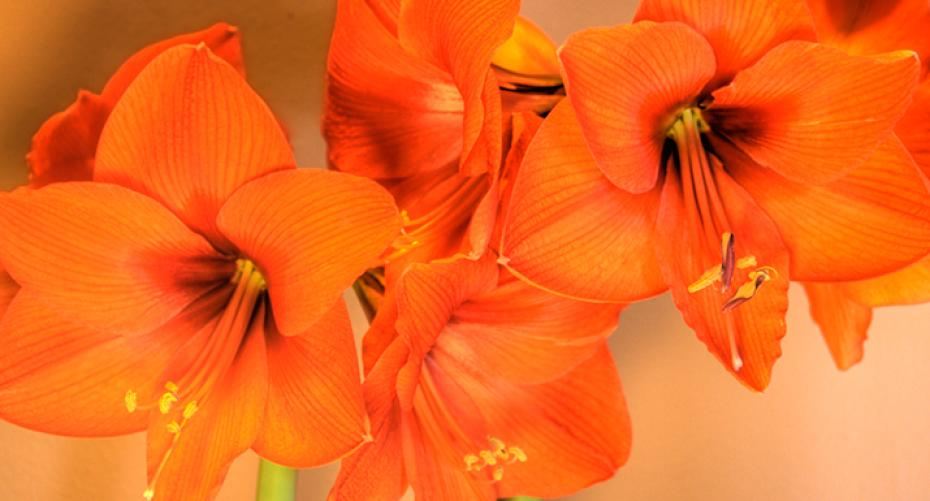The large-flowered Hippeastrum, popularly known as Amaryllis, are fascinating plants to grow & make a striking statement indoors. They start growth from a huge bulb and their long flowering stems grow quickly to reward you with large lily-like flowers from Christmas day to late spring. By starting bulbs into growth at different times, it’s possible to extend the flowering season, planting specially-prepared, first-rate bulbs, by the end of October, for flowers in time for Christmas – or later, for glamorous blooms in April and May.
Hippeastrum is native to the Americas but has been commercially bred since the 18th century. Today, exotic cultivars have been extensively bred around the world, with particularly beautiful double-flowered forms arising in Japan. Hippeastrum is a tender, indoor bulb not to be confused with its hardy outdoor relative Amaryllis. They are otherwise easy to grow - producing handsome, strap-like mid-green leaves with two to fifteen (depending on species) large dinner plate-sized trumpet flowers, held aloft on stout stems. Hippeastrum make an unusual alternative to the Christmas Poinsettia and make flamboyant houseplants and also long-lasting cut flowers, surviving for up to three weeks, when ‘prepared’ and treated with care. The bulbs also have the added advantage of lasting from year to year, getting larger and so offering additional flower spikes for your Christmas celebrations.
 When you are buying Hippeastrum bulbs you should look for ones that are firm to the touch and greenish-white in colour, with a papery skin similar to that of an onion. Also look out for signs of growth such as emerging flower spikes or leaves. Amaryllis like to be planted in a snug pot, slightly larger than the bulb, in John Innes no.2 potting compost, with the top half of the bulb left exposed.
When you are buying Hippeastrum bulbs you should look for ones that are firm to the touch and greenish-white in colour, with a papery skin similar to that of an onion. Also look out for signs of growth such as emerging flower spikes or leaves. Amaryllis like to be planted in a snug pot, slightly larger than the bulb, in John Innes no.2 potting compost, with the top half of the bulb left exposed.
For Christmas flowering, warmth is crucial, with an average 18˚C (65˚F) needed day and night, as soon as the prepared bulbs are planted. Bottom heat (above a radiator is ideal) is particularly beneficial to produce a strong root system before top growth develops, for later flowering, timings and temperatures are not so critical and a minimum of 13˚C (55˚F) will keep it happy.
Place the pot in a sunny, warm position on the windowsill, and keep the compost just moist, but not wet, until the flower buds emerge. Then move your bulb to a bright, cooler spot, to control growth rates and prolong flowering, turning plants daily to maintain straight flower stems.
Amaryllis bulbs also make excellent Christmas presents whether gift boxed or planted up in attractive containers, singly or in stunning groups of four or five. You can even make your own special display by planting a group in a shallow bowl then covering the compost with moss and decorating the gaps between the bulbs with twigs from which the flowering stems will erupt – this would make a fabulous centrepiece for a Christmas dinner table.
 Alternatively, you could grow the bulbs without soil in special vases designed for Hippeastrum, similar to those for hyacinth. First soak the roots of dry bulbs in water at room temperature, to make them pliable then fill the vase half-full with decorative gravel, pebbles, glass beads or marbles for extra stability. Carefully spread the Amaryllis roots out while adding more stones, until the roots and up to two-thirds of the bulb is covered. Add water up to the base of the bulb, but no higher, and keep this level maintained. Change the water once a fortnight – pouring out the old and refreshing with new, adding one tablespoon of charcoal to the stones, to prevent the growth of algae. Unfortunately, these bulbs will not flower again the following year because they have used all their resources.
Alternatively, you could grow the bulbs without soil in special vases designed for Hippeastrum, similar to those for hyacinth. First soak the roots of dry bulbs in water at room temperature, to make them pliable then fill the vase half-full with decorative gravel, pebbles, glass beads or marbles for extra stability. Carefully spread the Amaryllis roots out while adding more stones, until the roots and up to two-thirds of the bulb is covered. Add water up to the base of the bulb, but no higher, and keep this level maintained. Change the water once a fortnight – pouring out the old and refreshing with new, adding one tablespoon of charcoal to the stones, to prevent the growth of algae. Unfortunately, these bulbs will not flower again the following year because they have used all their resources.
To get your Amaryllis bulbs to flower again successfully, follow these five simple steps:
- Keep them active after flowering - move plants to a sunny spot and apply a liquid fertilizer every fortnight.
- Give them a holiday in midsummer (June or July) - place pots outside and keep well watered for continual growth.
- Gradually begin withholding water in August and bring the plants indoors for a rest, stop watering in September to allow the leaves to die down naturally.
- Tidy up the bulbs cutting off their leaves, and keeping them, still in their pots, at 10˚C (50˚F) until ready to start into growth again.
- Remove the top half of the compost or replace completely and begin watering, to trigger the bulbs into growth once more.


